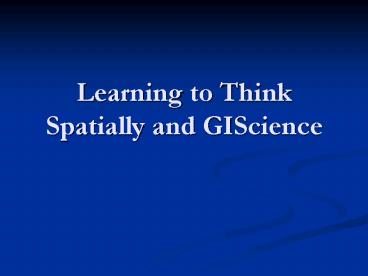Learning to Think Spatially and GIScience - PowerPoint PPT Presentation
1 / 14
Title:
Learning to Think Spatially and GIScience
Description:
... to another (as in creating 2-D maps from 3-D environments) ... Using frames of reference (such as latitude and longitude or local street numbering systems) ... – PowerPoint PPT presentation
Number of Views:17
Avg rating:3.0/5.0
Title: Learning to Think Spatially and GIScience
1
Learning to Think Spatially and GIScience
2
Everything is Spatial...well almost
- Spatialwhere is something
- Most activities on the earth and other planets
have a spatial or location-based connection - Spatial can be static or in motion
- Spatial things can also be called objects
3
Space in art
Gustave Caillebotte
Paris Street Rainy Day, 1877
4
Archeology and SpaceDo you know where this
is?Who were the inhabitants?What was the
functions of the buildings by location?
5
Where is it located?
- Most essential of geographic questions
- Can be absolute (i.e., longitude/lattitdue) or
relative location - An absolute location is conceptually difficult
without relative location (i.e., Fatih
University is located near Hadimköy Yolü in
Büyükçekmece, Istanbul, Türkiye.)
6
What are the characteristics?
- So...now we know the location... but there must
be more... - What happens at this location? (i.e., Fatih
University offers undergraduate and graduate
education.) - Does the spatial object have demensions? (i.e.,
How many square meters is Fatih University
campus?)
7
What are some spatial skills?
- Translating from one dimension to another (as in
creating 2-D maps from 3-D environments). - Realizing distance properties (such as adjacency,
proximity, similarity, nearest neighbor, crow-fly
distance, or "over-the-road" distance). - Comprehending orientation and direction (e.g., as
in using global references such as North, South,
East, and West, angular bearings, or clock-face
directions-as in "the statue is at two o'clock
from you"). - Using frames of reference (such as latitude and
longitude or local street numbering systems). - Realizing spatial geographic associations (such
as downhill snow skiing and mountains, the
relative lack of cities in desert areas, the
denser patterning of cities in fertile
agriculture areas, or the association between
dairy areas and cheese and butter factories). - Realizing that nations are "carved" into regions
that may be geographic, economic, social, or
political (such as ethnic neighborhoods,
production regions, school districts, census
tracts, and zip code areas). - Being aware of, and using effectively, the
spatial networks of roads and highways. - Recognizing systems of landmarks that anchor
one's cognitive maps. - Developing map-reading skills.
- Thinking Spatially
- By Reginald Golledge , University of California
Santa Barbara - January 12, 2003 in Directions Magazine
http//www.directionsmag.com/article.php?article_i
d277trv1
8
Examples of Spatial Questions
- Where is it?
- Where does it occur?
- What is there?
- Why is it there?
- Why is it not elsewhere?
- Why is it there rather than anywhere else?
- Do these things usually occur together in the
same places? - Why should they be spatially associated?
- Is it linked to other things?
- Has it always been there?
- What factors have influenced its spread?
- Why has it spread or diffused in this particular
way? - NCGIA Core curriculum 1997
9
spatial thinking and spatial technologies
- Spatial thinking is the logic behind spatial
technologies - The challange is translating spatial logic into
spatial technologies - Spatial technology developers and users
transform spatial questions into spatial answers
10
analog and digital
- We live in an analog world but the language of
spatail technologies is digital - What is real is translated and abstrated into
spatial technologies - Limitatations are enherent in this process
11
Analog
- Analog is any thing that is not put in the
language of computer - Examples would be printed material, vinyal
records (now used by DJs)
12
Digital
- 0s and 1s
- A method of transfering information
- Dependent upon computer technology
- Hardware, software, programming languages
- Requires a certain level of skills
13
Elements of Spatial Technologies
- Hardware
- Software
- Databases
14
Conclusion
- Geography is about exploring new territories
- The real world is not the digital world
- Our challage as geographers who use spatial
technologies is how we can use them to answer
geographic questions































